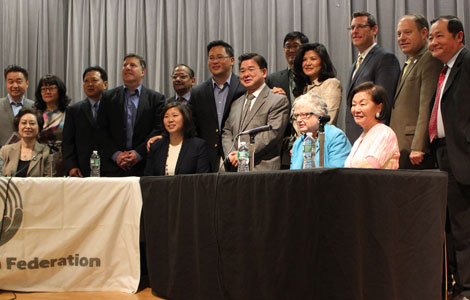Befriending China's academia
Updated: 2014-06-06 11:26
By Michael Barris (China Daily USA)
|
||||||||
|
Kean University Vice President of Student Affairs, Janice Murray-Laury (far right) welcomes the founding Wenzhou-Kean students in 2012. She is joined by Kean University (NJ, USA) student leaders (in matching blue shirts). Provided to China Daily |
Many US universities see a close China relationship as a way to attract top faculty members, students and resources. But that approach in a crowded market is challenging and involves risks, MICHAEL BARRIS reports from New York.
The urgency in Victor Zue's voice was unmistakable.
"If we don't engage with China now, 10 years from now we'll have to take a number," the Massachusetts Institute of Technology (MIT) electrical engineering and computer science professor said. "Our strategy must be driven by the desire to work with a potential peer."
Zue's words at an innovation and entrepreneurship forum at the renowned private research university in Cambridge, Massachusetts, last fall underscored the seriousness with which US higher-education institutions view the need to form closer ties with Chinese schools.
With new research and education opportunities growing daily in the world's second-largest economy, many US schools have prioritized collaborating with China in their quest to build global reputations and compete internationally for top faculty, resources and students.
But pursuing a meaningful relationship with Chinese academia is no cinch. And it can be a risky proposition, potentially damaging a school's standing or costing it precious dollars if the outreach backfires, according to experts.
"Everybody is trying to partner with the same Tsinghuas and Peking universities of the world," said Rahul Choudaha, chief knowledge officer with World Education Services, a New York-based international-education research organization.
"Of course, they are not available to partner with everyone. So that mismatch between what (US) universities may want to do and what the reality may be once they reach out to a particular market is sometimes a surprise for some institutions."
US academia's fascination with China's higher-education institutions has grown as years of intensive education investment by the Chinese government aimed at expanding the nation's economy have broadly upgraded China's academic bona fides.
The Asian nation now holds an edge over the US in awarding higher education diplomas. The number of Chinese graduating from a university has swollen sevenfold since 1999 to nearly 7 million last year, according to a recent National Science Foundation report.
China also has gained an advantage over the US in producing "first university degrees", or programs that open the gate into advanced research programs or jobs, according to the February report from the NSF, an independent US Congressional agency.
The increasing youthfulness of Chinese US university students is seen as expanding opportunities for US-China research collaboration. "Traditionally, Chinese students used to come (to the US) for master's and doctoral degrees," Choudaha said. "Increasingly, they are coming at a younger age for undergraduate degrees."
Grad students
Chinese grad students' embrace of US business-education programs played a role in the setting of US-China business-school partnerships, currently numbering 329, the highest between two countries, according to the Association to Advance Collegiate Schools of Business, or AACSB, a global nonprofit group of educational institutions.
China's role as the US's largest source of doctoral students also provides a doorway to research opportunities. More than 63,000 Chinese students earned US science and engineering doctorates from 1991 to 2011, accounting for 27 percent of the awards to foreign students, according to the AACSB. "This large research talent base of Chinese doctorates would further facilitate research collaborations when some of them go back to China," Choudaha said.
MIT's pursuit of a deeper China engagement underscores how even a top school with dozens of Nobel laureates and National Medal of Science recipients and a 130-year history of engaging China, prioritizes the need to befriend Chinese academia.
A 2010 report to MIT's president prepared by the MIT Greater China Strategy Group urged the school's administration to provide funding for an ambitious plan for China engagement that would "prepare our students and faculty for the increasingly connected world in which China plays an ever more prominent role".
"China is very important to MIT's future," the report, titled the MIT-Greater China Strategy, began. "The phenomenal growth in this region of the world - economically, technologically, and politically - means that our graduates are increasingly asked to work with people in China, or even to work in China."
With issues such as air pollution, environmental degradation, urbanization and traffic congestion, China, the report noted, "offers some of the most challenging problems, whose solutions may be different from those in the Western world. For MIT to remain a leader in global problem solving, we need to engage deeply with China."
"Whether in infrastructure, energy and the environment, transportation and logistics, neuroscience, economics or medicine and the life sciences, China is where some of the most interesting problems will be, and where some of the best answers will come from," according to the report.
Zue, who chaired the MIT China strategy group that produced the report, told the MIT-China Innovation and Entrepreneurship Forum (MIT-CHIEF) conference in November that although MIT has had many different relationships with various nations, China's size and growth have elevated the importance of China ties. China's "tremendous investments to upgrade its universities" mean that "very soon they are going to be at the level of the United States", Zue said. "The impact of this relationship will far exceed any relationship that we have had."
The strategy report called for promoting collaboration between faculty, research staff, students and their Chinese counterparts, establishing special relationships with Chinese academic institutions, establishing an MIT-China innovation hub that links research, education and innovation, developing executive education style training programs for governmental officials, educators and researchers in science, technology and innovation, as well as business practitioners and establishing a resource development effort to support the implementation of its China strategy.
In an email to China Daily, Zue said that since the report was issued, MIT "continues to work aggressively towards China engagement". In addition to the MIT-CHIEF annual conferences in Cambridge, a major MIT-China conference was held last October in Beijing. He also cited a consortium of 29 leading Chinese universities' selection last fall of edX's open source platform - developed by MIT and Harvard University - to power China's newest and largest online learning portal, XuetangX. The massive open online course and blended learning portal will feature courses from leading universities in China.
Claude Canizares, co-chair of the MIT International Advisory Council that helps to shape MIT's international strategy, said MIT is "continuing to build connections along many fronts, in keeping with the recommendations of the MIT Strategy report", but didn't offer details.
China's centralized government is eager to draw on the expertise of Western academia to solve its growth-related problems, according to the report. "As China becomes much more of a stakeholder in such issues as trade, diplomacy, scientific development, manufacturing and education, the Chinese have been seeking partners who can integrate the People's Republic into key global systems. .. There is a once-in-a-century opportunity for MIT to serve as one of China's valuable partners in scientific, economic and educational development in the 10 to 20 year horizon," the report said.
Emphasizing collaboration
Since the publication of its 2006 medium and long-term national plan for science and technology development, China has emphasized collaboration. That year, China spent a $136 billion on research and development, making it the world's second-highest R&D investor after the US. The 12th Five Year Plan, issued in 2011, said China will actively expand imports of foreign technology and brings in "senior talent" and advanced technology from overseas to set up R&D centers in China.
MIT is not alone among Western universities in wanting to be part of the "China story", Choudaha said. "Missing that story in your education research experience is a big loss, not just academically but, for many, financially also. Just being part of the whole China equation is not even a choice anymore for a lot of institutions. It's a necessity," he said.
Typically, a US-China university collaboration starts with a student exchange program in which Americans study in China, or Chinese students attend US schools. From there, the relationship can grow to include cross-border academic collaboration and even the establishing of outposts in the Asian nation. Each layer of engagement carries its own level of risk, depending on the resources required to build engagement, Choudaha said.
Student exchanges are "relatively low-risk" endeavors with a "low return in terms of the extent of engagement", Choudaha said. China is no stranger to student exchanges. The number of Americans studying in China increased by more than 500 percent in the past 10 years, making China one of the top 10 study-abroad destinations for US students, and one of the top 10 host countries for all international students, according to the Institute of International Education, an independent nonprofit international education and training organization.
Some 800,000 Chinese students and scholars have studied outside their home country since 1978, when Deng Xiaoping began to send students and scholars to study abroad in large numbers as part of his broad modernization efforts.
Research partnerships are seen as a relatively low-risk way for US schools to engage China's university community. George Washington University's Sigur Center for Asian Studies, an international research center, has awarded more than $1 million to students and faculty for intensive language study and field research in Asia.
The Indiana University Maurer School of Law and China University of Political Science and Law announced on May 22 a cooperation agreement that would establish the Academy for the Study of Chinese Law and Comparative Judicial Systems, affiliated with China University of Political Science and Law's Collaborative Innovation Center of Judicial Civilization.
The new academy will "foster lecture and research exchanges among leading faculty at both Indiana University and China University of Political Science and Law," according to a release.
While branch campuses can bring benefits such as attracting top researchers and grants and providing access to a new pool of students as the number of college-age Americans declines, the venture is high-risk. A branch campus project involves "very high investment, high return and a high degree of commitment to the partnerships between the two countries," Choudaha said.
Yale University has dozens of research collaborations with Chinese universities. In 2007, the New York Institute of Technology, a private university offering career-oriented training, opened a Nanjing campus in collaboration with Nanjing University of Posts and Telecommunications, and dozens of US universities offer joint or dual degrees through Chinese universities.
Kean University
Kean University-Wenzhou, a 300-acre campus of New Jersey's public Kean University in Wenzhou, Zhejiang province, went into operation this year. The degree-granting branch campus currently is operating as a three-year pilot project with Wenzhou University, with Chinese provincial and municipal governments funding the construction and operation. The project received a 1.5 billion yuan ($236 million) investment from China's Ministry of Education last year.
Kean, which maintains academic control of the campus, making all curriculum and hiring decisions, is one of only three US universities approved to operate a full-scale campus in China. The other two are New York University and the University of California, Berkeley.
An outreach to Chinese academia involves a journey across an already crowded playing field.
"The challenge for some American universities is that in the reputation building process there has always been a kind of fashion parade," Choudaha said. "Every institution wants to partner with one that has a higher ranking than their own institution."
Since the number of potential partners for top schools is limited, "it may take US universities longer to find a peer than was anticipated initially".
The highest-ranked universities that are coveted by partners in foreign countries often receive subsidies for construction, rent or other costs. Second-tier schools - the ones that are good but not in the same league as Harvard, MIT and Columbia - are left fighting it out for China's attention.
US schools eyeing outposts in China also have to contend with a challenge from UK and Australian schools, he said.
But while many US universities strive to establish programs in China to raise their reputation and attract foreign students, problems have led some to reconsider expansion.
A notable example is Duke University's plan to set up a campus in Kunshan, Jiangsu province. Originally set to open in 2012, the project has been plagued by construction setbacks, and is now slated to open in August. Duke also scaled back planned business-school courses after faculty expressed concerns about low demand.
Duke is spending an estimated $8 million on startup costs and $6 million annually over seven years at its China outpost while the city of Kunshan is spending an estimated $260 million to build the 200-acre campus.
While the opening delay is unfortunate, "it's given us more time to be thoughtful about what we're going to do," William Boulding, dean of Duke's Fuqua School of Business, in Durham, North Carolina, was quoted by Bloomberg News.
Although the financial loss can inflict pain on a medium-ranked school at a time of scant public funds, failing in a China outreach can be even more costly for an elite school when its reputation is impugned.
"The bigger ones are putting a much bigger risk on their reputation," Choudaha said. "The scars from reputational damage will last for a much longer time."
To some observers, the rocky attempts to engage China are just growing pains in a larger US-China higher-education relationship.
"In the next five to 10 years, more international activity will be happening in China than outside China," Choudaha said. And as more foreign university campuses appear in the Asian nation, the number of students who want good international education at home will "expand significantly". The number of students continuing to go abroad to study will "stagnate", he said.
The implications of such a change for US schools won't be known for five to 10 years, but they could be significant, Choudaha said. "American universities are becoming dependent on the China talent supply chain."
The risks notwithstanding, US schools' collaboration with Chinese universities is in the US schools' best interest, according to Tom Watkins, a former Michigan state superintendent of schools and a member of the University of Michigan Confucius Institute board of advisors.
"There is not a major issue today that does not impact China," Watkins said in an interview. "The world has a stake in assuring that China prospers."
Contact the writer at michaelbarris@chinadailyusa.com

 The Silk Road rediscovered
The Silk Road rediscovered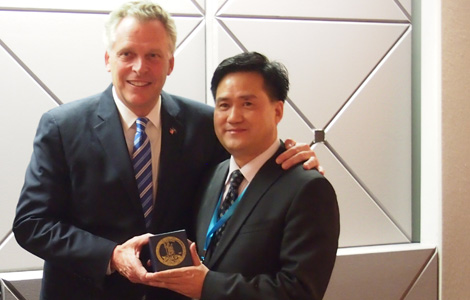
 Chinese firms seek partners in Virginia
Chinese firms seek partners in Virginia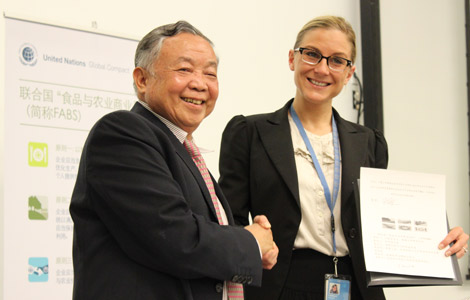
 Company signs UN business principles
Company signs UN business principles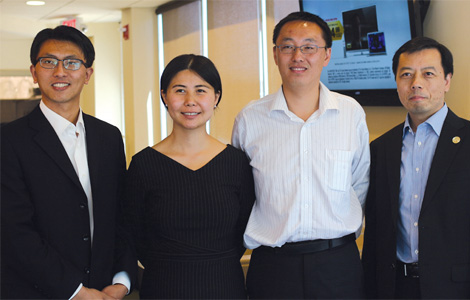
 Asian youths get a day of science, math, innovation
Asian youths get a day of science, math, innovation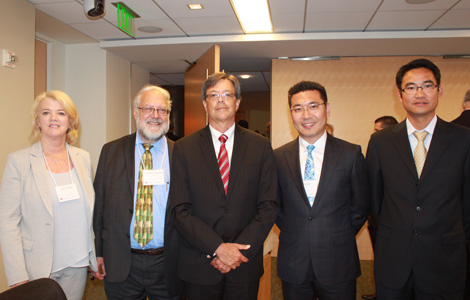
 US, China can share on climate: panel
US, China can share on climate: panel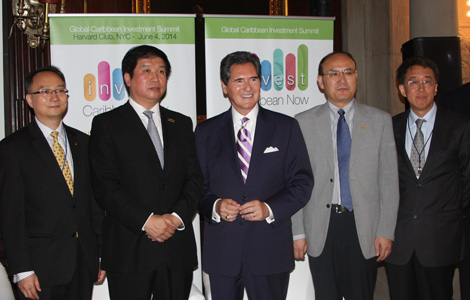
 Caribbean overlooked for investing, tourism: panel
Caribbean overlooked for investing, tourism: panel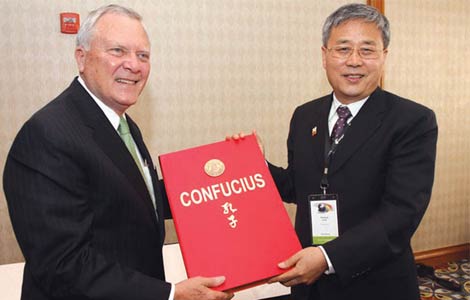
 Georgia helps Shandong climb up the value chain
Georgia helps Shandong climb up the value chain
 Low carbon never means low fun
Low carbon never means low fun
Most Viewed
Editor's Picks

|

|

|

|

|

|
Today's Top News
Silk Road offers Sino-Arabian blueprint
US issues biased report on China's defense spending
Death penalties in Xinjiang reflect crackdown on terror
More Sino-US space co-op expected
NBA launches outreach in China
Clinton 'love to see' female leader
Naval drill may calm choppy ties with the US
US needs to reexamine NASA's China exclusion policy
US Weekly

|

|


